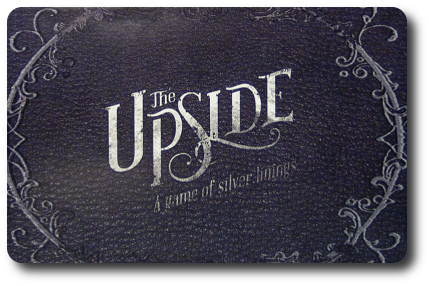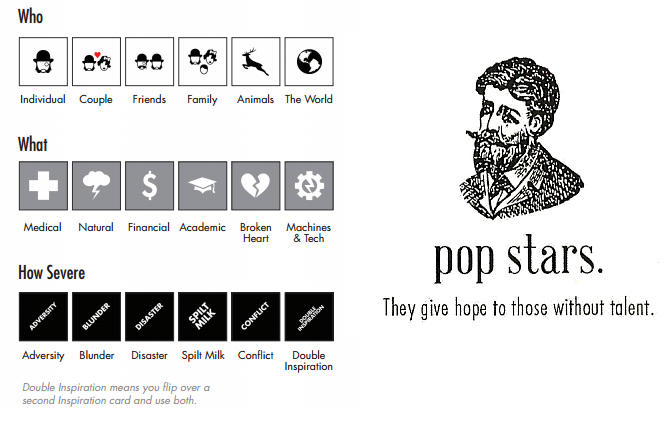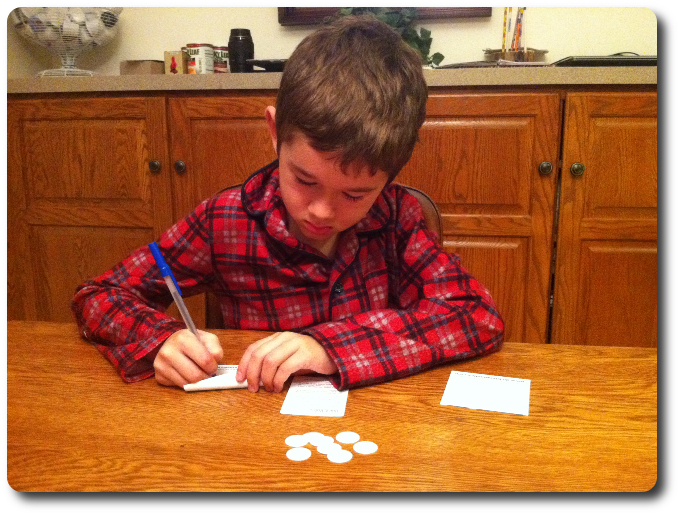
The Basics:
- For ages 9 and up (publisher suggests 12+)
- For 2 to 5 players
- Variable game play length
Geek Skills:
- Active Listening & Communication
- Counting & Math
- Logical & Critical Decision Making
- Reading & Writing
Learning Curve:
- Child – Easy
- Adult – Easy
Theme & Narrative:
- Find the sliver-lining in absurdly difficult situations
Endorsements:
- Gamer Geek approved!
- Parent Geek approved!
- Child Geek approved!
Overview
Winston Churchill said, “A pessimist sees the difficulty in every opportunity; an optimist sees the opportunity in every difficulty.” In this game of outrageous misfortune, every player is asked to be an opportunist to the extreme. The worst possible situation you can imagine is about to be presented. The goal is simple: flip difficulty into opportunity. Not an easy task. Sometimes finding the upside is an uphill struggle, but well worth the effort.
The Upside, a self-published game designed by Kevin Warner and Jonathan Zarco, is comprised of 3 Story dice, 8 Quick Start rule cards, 44 Inspiration cards, 100 Positive Point tokens, and 1 60-second timer. Not included with the game, but necessary to play, is a pen or pencil and a several small pieces of paper for each player.
Game Set Up
Note: Prior to your first game play, you will be required to apply stickers to the 3 Story dice in the game. This is not a difficult processes and won’t take you long to complete.
To set up the game, give each player a Quick Start rule card. Place any Quick Start rule cards not used back in the game box.
Second, shuffle the Inspiration cards and place the deck face-down in the middle of the playing area. This is the Inspiration draw deck for the duration of the game. Leave room next to the deck for a discard pile.
Third, place the Positive Point tokens in a pile in the center of the playing area next to the Inspiration draw deck. I suggest you put the tokens into a small cup to help keep the playing area tidy.
Fourth, give each player a pen or pencil and several small pieces of paper.
That’s it for game set up. Hand the 3 Story dice to the first player and begin.
Accentuate the Positive
The Upside is played in turns with no set number of turns or rounds per game. A single turn is completed by following a small number of sequential steps.
Step 1: Roll the Story Dice & Reach for Inspiration
The player with the Story dice is referred to as the turn’s “Storyteller”. The Storyteller rolls the 3 Story dice to determine specific aspects of a disastrous event they are about to create. Specifically, the “Who”, the “What”, and the event’s level of severity. The Storyteller then draws 1 Inspiration card that describes an event or general topic that forms the backbone of the problem the players must find a positive spin on.

All possible dice values shown with one example of an Inspiration card
After the Storyteller has a few moments to think about it, they briefly describe a disastrous event using the 3 Story dice and the Inspiration card. Let’s look at an example.
The Story dice rolls and the Inspiration card is as follows:
- Inspiration: “Ninjas”
- Who: The World
- What: Machines & Tech
- How Severe: Conflict
As you can see, the dice results and Inspiration card provide the building blocks, but not the story. The Storyteller is welcome to use all or some of what is available to them to create a description of the disaster. For example, the Storyteller could say, “A few days from now, the world will be invaded by an alien species that use robotic Ninjas to wage war on humanity!” Gads, that would stink…
Step 2: Being Realistically Optimistic
Each player now writes down the upside of the event. That is, the positive aspects of the otherwise terrible disaster that has befallen them. The Storyteller can either give the players all the time they need or use the 60-second timer to limit the time available to the players. Once the player has completed writing their positive take on the negative situation, they fold their piece of paper and put their pen or pencil down, signifying they are ready for the next step.
Players should attempt to craft a response that is relevant, unique, optimistic, and positive. It also helps if it’s highly outrageous. The Storyteller will judge the merit of the player’s response using these guidelines, which means a player should also craft a response that they think will resonate with the Storyteller. Let’s look at an example response.
- Player 1 writes: “At least Ninjas consider it dishonorable to use probes.”
- Player 2 writes: “On the upside, we no longer have to worry about which is more of a danger: Alien Pirates or Alien Ninjas.”
- Player 3 writes: “Good thing I don’t believe in Ninjas. If I can’t see them, I don’t think they exist.”
If you were the Storyteller, which one of the above do you think is the most relevant, unique, optimistic, and positive? Here’s a hint: there is no right answer. Every Storyteller will have to decide for themselves and any decision made will be highly subjective.
Step 3: Judging the Silver Lining
The players now exchange their answers with another player. This can be done by placing all the answers in the middle and then randomly selecting them or any other method that works for the group. The objective is to make certain the Storyteller doesn’t know who wrote what.
One at a time, each player will read what is written on the piece of paper they have. The Storyteller will then award Positive Points as follows:
- 1 Positive Point is given to the player who the Storyteller believes provided the best answer
- 1 Positive Point is given to each player the Storyteller believes provided a positive and valid answer
Any collected Positive Point tokens are placed in front of the player. A player cannot earn anymore than 2 Positive Points per response.
Players can challenge an opponent’s response if they believe it’s not valid. The Storyteller will decide if the response is valid or not and has the final say. The Storyteller can also decide if a response is not valid on their own, but they best be prepared to explain why. The rules provided do not clearly state what does or does not make a response valid. Each group will have to tackle that dilemma on their own.
This completes the turn. The Inspiration card is discarded and the player to the Storyteller’s left is the new turn’s Storyteller.
Ending the Game
The game continues until 1 player has collected 13 or more Positive Point tokens at the end of a turn.
To learn more about The Upside, visit the game’s official website.
Prediction
In my opinion, a good party game is one that allows its participants to be creative and social in equal measure. I see The Upside providing such an experience without issue. What I’m very excited about is observing how the game plays differently within our groups. For the Child Geeks, I believe their answers will be surprisingly insightful; children see the world through different eyes than adults. I’m betting the Parent Geeks will do their best to be as humorous and as lighthearted as possible, as befits their casual nature. I expect the Gamer Geeks to be exceedingly sarcastic and very colorful with their responses. The level of detail and severity of the disastrous situations will depend on the dice and the Inspiration card, but also a great deal on the Storyteller’s imagination. Regardless, I see the game doing very well with all 3 of our groups.
Teaching The Upside is best done by providing several examples. Creative types will be able to grasp the game’s concept fairly quickly. Those players who need well-defined, concrete examples will be hurting. The only thing that can be done to satisfy both extremes is to roll the Story dice, pick an Inspiration card, and throw out some possible silver-linings. Do expect a few players to raise their eyebrows, as some of your responses might not resonate with them. Which is fine, as every player will be bringing to the table a unique outlook. Some players are naturally optimistic, while others are not.
The Upside does require its players to be able to write and read. If you want to play with younger Child Geeks who cannot yet write or read, I suggest you team them up with an older player. Then the younger Child Geeks can participate by helping their older team member come up with a positive spin on a dismal situation. This is what I plan on doing and it opens up the game to everyone, regardless of age or life experience. After teaching the game to my little geeks, I asked them their thoughts on The Upside.
“I don’t get it.” ~ Liam (age 9)
“So it’s a game about being happy no matter what?” ~ Nyhus (age 6)
“I don’t want to play, Daddy.” ~ Ronan (age 4)
Admittedly, the game’s concept is a bit difficult to grasp, even after an example or two is provided. I think players are only really going to “get it” once they have had an opportunity to write their own positive outlooks and craft their own disastrous events. Let’s play The Upside and see if everything turns out for the best, or the game is a dismal disappointment.
Final Word
The Child Geeks floundered at first. They attempted to structure their responses in a very logical way, which was a problem. Some of the Child Geeks had a hard time finding the bright side of events and became frustrated as a result. This was not unexpected and I paused the game to talk about what was being asked of each player. One Child Geek said, “I don’t know if I can find anything good about a really bad thing.” A valid point, but I responded by telling them that sometimes you have to look really hard to find something really good. It should come as no surprise that we did not introduce the timer to the game, so as to provide all our Child Geeks as much time as necessary to think about their response. I’m pleased to report that the longer they played the game, the easier their answers came. The Upside requires its players to think a certain way and view each event from oftentimes strange perspectives. What all the Child Geeks eventually learned, however, is that the most outrageously difficult situation calls for the most outrageously optimistic point-of-view. Once they understood this simple concept, they no longer had any issues and their level of enjoyment skyrocketed. Instead of gloomy faces and furrowed brows, laughter was in the air and smiles abounded at the table. One Child Geek said, “What I like about this game is that everything can be good, no matter how many zombies are attacking.” I fully agree. All the Child Geeks voted to approve the game.

My little geek pauses for a moment to consider how a flesh-eating virus could be a “good thing”
The Parent Geeks reacted exactly the way I thought they would. The less creative and quieter individuals had a harder time with the Storyteller role, but all the players did very well with their responses. A few of the Parent Geeks took some of their responses to strange and dark places. I wouldn’t mention it if it weren’t for the fact that some of the weirdest responses came from some of the most uptight individuals you’d ever hope to meet. In some respects, The Upside allowed pessimists to be uniquely optimistic. And here I must pause for a moment and smirk. The majority of the winners of the game were more times than not individuals I would not consider overly optimistic or open people. I found that very odd and amusing. Not at all odd was the Parent Geeks’ response to the game. According to one Parent Geek, “This is an excellent game that makes you think and entertains you all at the same time.” The Parent Geeks gave The Upside their full endorsement, finding it to be a game they enjoyed as much with their family as they did with their peers.
The Gamer Geeks, as expected, took the game to dark and seedy places. For me, this was the group I enjoyed the game with the most. Many of the responses were inside jokes and all of the disastrous events were outrageously horrible to the extreme. For example, a plague that made everyone look like Carrot Top after his plastic surgery. The horror! Of course, the more horrible the event, the more humorous the responses. According to one Gamer Geek, “This is one of those party games I’d play at conventions and with friends at home.” All the Gamer Geeks agreed, with a number of them adding that The Upside would be a lot of fun to play if they were inebriated, which they were in some cases. The game has little in the way tactics, but the strategy is very clear: appease the Storyteller. All of the Gamer Geeks understood this and played it up beautifully. When the game was put away, all the Gamer Geeks voted to approve it and looked forward to playing it again.
The Upside could be seen as a humorous game that tries to put on a serious face. Of course, it fails to fool anyone and you can clearly see that the game itself doesn’t take itself seriously. Which is good, because life is already too serious as it is. I found the game to be strangely therapeutic, especially when I was playing it when I was having some difficult situations in my personal life. It helped me to remember that I was taking too many things too seriously. As an adult, we have a great deal of responsibility. That can sometimes feel like the weight of the world and lead us to forget how good we really have it. Taking a moment to consider horrible situations that would never happen and then finding a positive spin on it got me thinking about my own situations. Truly, thinking positively leads to positive feelings.
I would highly recommend The Upside to Parent and Gamer Geeks. It’s casual and fun, allowing different groups to play the game in a way that feels natural to them. The timer was never used, which leads me to believe it’s not necessary, but it’s there if you want it. For the Child Geeks, they enjoyed themselves, but finding positive outcomes to horrible events can lead to frustration, as it did with ours. Take it slow and the Child Geeks will do fine.
Play The Upside when you get the chance. The challenge is not in realizing how bad a situation is, but seeing how even the worst possible scenario could have a very positive outcome. And that’s a lesson I think we could all benefit from.
This game was given to Father Geek as a review copy. Father Geek was not paid, bribed, wined, dined, or threatened in vain hopes of influencing this review. Such is the statuesque and legendary integrity of Father Geek.




Pingback: Today in Board Games Issue #94 - Today in Board Games